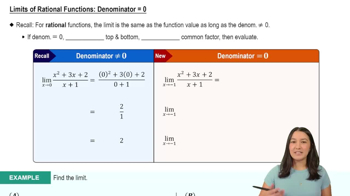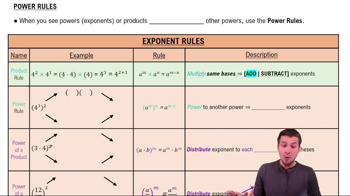[Technology Exercise] Grinding engine cylinders Before contracting to grind engine cylinders to a cross-sectional area of 9in², you need to know how much deviation from the ideal cylinder diameter of c = 3.385in. you can allow and still have the area come within 0.01in² of the required 9in². To find out, you let A=π(x/2)² and look for the largest interval in which you must hold x to make |A − 9| ≤ 0.01. What interval do you find?
Table of contents
- 0. Functions7h 54m
- Introduction to Functions16m
- Piecewise Functions10m
- Properties of Functions9m
- Common Functions1h 8m
- Transformations5m
- Combining Functions27m
- Exponent rules32m
- Exponential Functions28m
- Logarithmic Functions24m
- Properties of Logarithms36m
- Exponential & Logarithmic Equations35m
- Introduction to Trigonometric Functions38m
- Graphs of Trigonometric Functions44m
- Trigonometric Identities47m
- Inverse Trigonometric Functions48m
- 1. Limits and Continuity2h 2m
- 2. Intro to Derivatives1h 33m
- 3. Techniques of Differentiation3h 18m
- 4. Applications of Derivatives2h 38m
- 5. Graphical Applications of Derivatives6h 2m
- 6. Derivatives of Inverse, Exponential, & Logarithmic Functions2h 37m
- 7. Antiderivatives & Indefinite Integrals1h 26m
- 8. Definite Integrals4h 44m
- 9. Graphical Applications of Integrals2h 27m
- 10. Physics Applications of Integrals 3h 16m
- 11. Integrals of Inverse, Exponential, & Logarithmic Functions2h 31m
- 12. Techniques of Integration7h 41m
- 13. Intro to Differential Equations2h 55m
- 14. Sequences & Series5h 36m
- 15. Power Series2h 19m
- 16. Parametric Equations & Polar Coordinates7h 58m
1. Limits and Continuity
Introduction to Limits
Problem 2.4.28
Textbook Question
Using limθ→0 sin θ / θ = 1
Find the limits in Exercises 23–46.
limt→0 2t / tan t
 Verified step by step guidance
Verified step by step guidance1
Recognize that the limit involves a trigonometric function, specifically tan(t), which can be expressed in terms of sin(t) and cos(t). Recall that tan(t) = sin(t) / cos(t).
Rewrite the expression 2t / tan(t) as 2t / (sin(t) / cos(t)), which simplifies to 2t * (cos(t) / sin(t)).
This can be further simplified to (2t * cos(t)) / sin(t).
To apply the known limit lim(θ→0) sin(θ) / θ = 1, rewrite the expression as (2 * cos(t)) * (t / sin(t)).
Recognize that as t approaches 0, t / sin(t) approaches 1, and cos(t) approaches cos(0) = 1. Therefore, the limit can be evaluated by considering the product of these limits: 2 * 1 * 1.
 Verified video answer for a similar problem:
Verified video answer for a similar problem:This video solution was recommended by our tutors as helpful for the problem above
Video duration:
3mPlay a video:
Was this helpful?
Key Concepts
Here are the essential concepts you must grasp in order to answer the question correctly.
Limit of a Function
The limit of a function describes the value that a function approaches as the input approaches a certain point. In calculus, limits are fundamental for understanding continuity, derivatives, and integrals. The notation lim(x→a) f(x) indicates the limit of f(x) as x approaches a. Evaluating limits often involves techniques such as substitution, factoring, or using special limit properties.
Recommended video:

Limits of Rational Functions: Denominator = 0
Trigonometric Limits
Trigonometric limits, particularly those involving sine and tangent functions, are essential in calculus. A key result is lim(θ→0) sin(θ)/θ = 1, which helps evaluate limits involving sine and tangent as they approach zero. This result is crucial for simplifying expressions and solving problems that involve trigonometric functions, especially in the context of derivatives and integrals.
Recommended video:

Introduction to Trigonometric Functions
L'Hôpital's Rule
L'Hôpital's Rule is a method for evaluating limits that result in indeterminate forms like 0/0 or ∞/∞. It states that if the limit of f(x)/g(x) as x approaches a yields an indeterminate form, then the limit can be found by taking the derivative of the numerator and the derivative of the denominator. This rule simplifies the process of finding limits, especially when dealing with complex functions.
Recommended video:
Guided course

Power Rules

 6:47m
6:47mWatch next
Master Finding Limits Numerically and Graphically with a bite sized video explanation from Patrick
Start learningRelated Videos
Related Practice
Textbook Question
